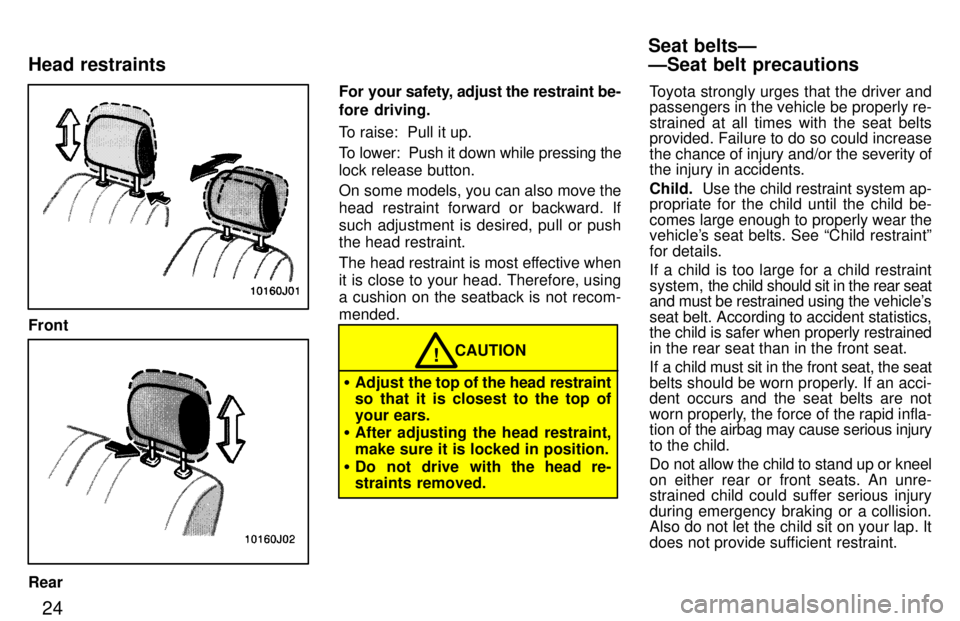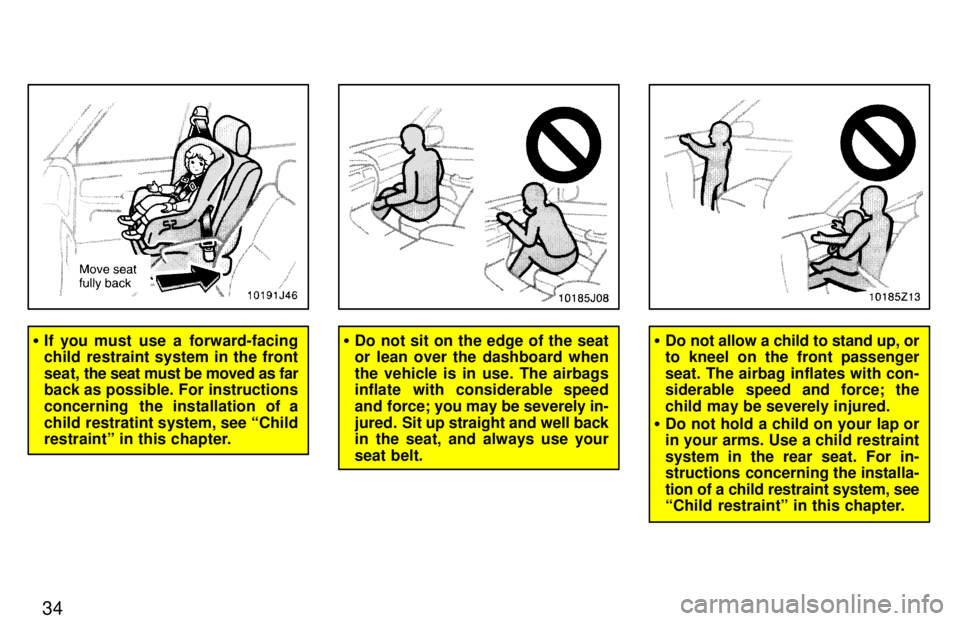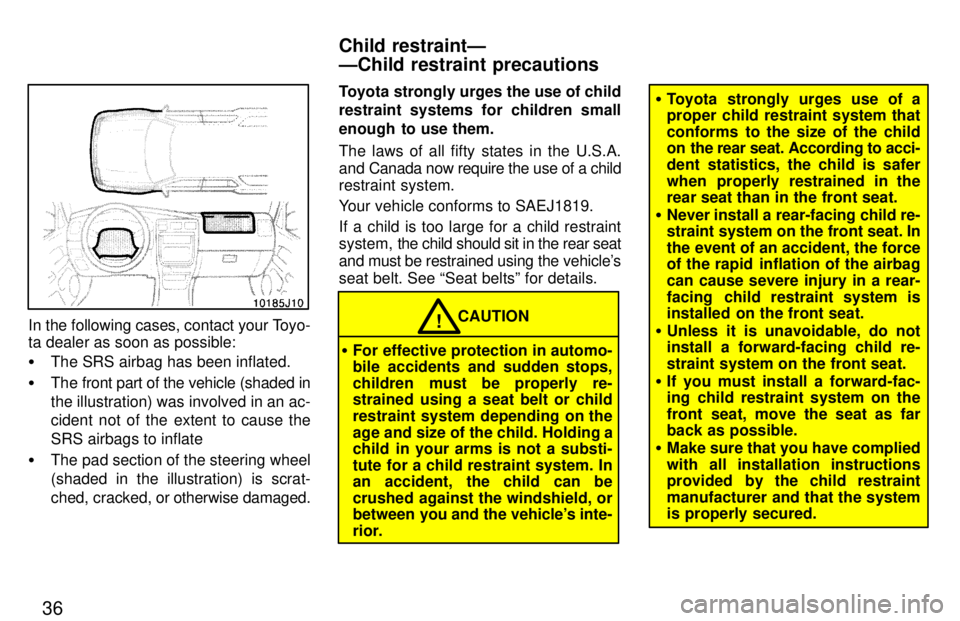1997 TOYOTA 4RUNNER airbag
[x] Cancel search: airbagPage 6 of 223

Indicator symbols on the instrument panel5
Unengaged Parkº warning light *1
Brake system warning light *1
Seat belt reminder light* 1
Discharge warning light* 1
Low oil pressure warning light* 1
Malfunction indicator light* 1
Low fuel level warning light * 1 Open door warning light*
1
SRS airbag warning light* 1
Automatic transmission fluid
temperature warning light* 1
Turn signal indicator lights
Headlight high beam indicator light
Over-drive indicator light
Anti-lock brake system warning
light * 1 Low windshield washer fluid level
warning light*
1
Page 20 of 223

24
Front
RearFor your s
afety, adjust the restraint be-
fore driving.
To raise: Pull it up.
To lower: Push it down while pressing the lock release button.
On some models, you can also move the
head restraint forward or backward. If
such adjustment is desired, pull or push the head restraint.
The head restraint is most effective when
it is close to your head. Therefore, using a cushion on the seatback is not recom- mended.
CAUTION!
� Adjust the top of the head restraint
so that it is closest to the top of
your ears.
� After adjusting the head restraint,
make sure it is locked in position.
� Do not drive with the head re-
straints removed. Toyota strongly urges that the driver and passengers in the vehicle be properly re- strained at all times with the seat belts
provided. Failure to do so could increase
the chance of injury and/or the severity of the injury in accidents. Child.
Use the child restraint system ap-
propriate for the child until the child be-
comes large enough to properly wear the
vehicle's seat belts. See Child restraintº
for details.
If a child is too large for a child restraint
system, the child should sit in the rear seat
and must be restrained using the vehicle's
seat belt. According to accident statistics, the child is safer when properly restrained
in the rear seat than in the front seat.
If a child must sit in the front seat, the seat
belts should be worn properly. If an acci- dent occurs and the seat belts are not
worn properly, the force of the rapid infla-
tion of the airbag may cause serious injury
to the child.
Do not allow the child to stand up or kneel
on either rear or front seats. An unre-
strained child could suffer serious injury
during emergency braking or a collision.
Also do not let the child sit on your lap. It
does not provide sufficient restraint.
Seat beltsÐ ÐSeat belt precautions
Head restraints
Page 27 of 223

31
The SRS (Supplemental Restraint Sys-
tem) airbags are designed to provide
further protection to the driver and
front passenger when added to the pri-
mary protection provided by the seatbelts.
In response to a severe frontal impact, the
SRS airbags work together with the seat
belt to help preventing or reduce injury by inflating, in order to decrease the likeli-
hood of the driver's or front passenger's
head or chest directly hitting the steering
wheel or dashboard. The passenger air-
bag is activated even with no passenger
in the front seat.This indicator comes on when the
ignition key is turned to the ACCº or
ONº position. It goes off after about 6
seconds. This means the SRS airbag
is operating properly.
The SRS airbag warning light system
monitors the airbag sensor assembly, in-
flators, warning light, interconnecting wir-
ing and power sources.The SRS airbag system is designed to
activate in response to a severe frontal
impact within the shaded area be-
tween the arrows in the illustration.
The SRS airbags will deploy if the severity
of the impact is above the designed
threshold level, comparable to an approxi-
mate 20 km/h (14 mph) collision when im-
pacting straight into a fixed barrier that
does not move or deform.
If the severity of the impact is below the
above threshold level, the SRS airbags
may not deploy.
SRS airbag
Page 28 of 223

32
However, this threshold velocity will be
considerably higher if the vehicle strikes
an object, such as a parked vehicle or sign
pole, which can move or deform on im-
pact, or if it is
involved in an underride col-
lision (e.g. a collision in which the noise of
the vehicle underridesº, or goes under, the bed of a truck). It is possible with collision severity at the marginal level of airbag sensor detection
and activation that only one of your ve-
hicle's two airbags will deploy. For your safety of all occupants, be sure to always wear seat belts.
The SRS airbags are not designed to inflate if the vehicle is subjected to a
side or rear impact, if it rolls over, or if
it is involved in a low-speed frontalcollision.The SRS airbag system mainly consists
of the following components and their
locations are shown in the illustration.
1 SRS airbag warning light.
2 Steering wheel pad (airbag and inflat- or)
3 Passenger airbag module (airbag and inflator)
4 Airbag sensor assembly.
The airbag sensor assembly consists of a
safing sensor and airbag sensor.
Page 29 of 223

33
In a severe frontal impact, sensor detects
deceleration and the system triggers the
airbag inflator. Then a chemical reaction
in the inflator momentarily fills the airbags
with non-toxic nitrogen gas to help re-
strain the forward motion of the occu- pants. When the airbag inflates, they produce a fairly
loud noise and release some smoke
along with the nitrogen gas. This is notharmful and does not indicate a fire. Be
sure to wash off any residue as soon as
possible to prevent minor skin irritation.
Deployment of the airbags happens in a
fraction of a second, so the airbags must
inflate with considerable force. While the
system is designed to reduce serious inju-
ries, it may also cause minor burns or
abrasions and swellings.
Parts of the airbag module (steering
wheel hub, dashboard) may be hot for several minutes, but the airbags them- selves w ill not be hot. The airbags are de-
signed to inflate only once.
A crash severe enough to inflate the air-
bags may break the windshield as the ve-
hicle buckles. In vehicles with a passen-ger airbag the windshield may also be
damaged by absorbing some of the force
of the inflating airbag.
CAUTION!
� The SRS airbag system is de-
signed only as a supplement to
the primary protection of the driv-
er side aseat belt systems. The
driver is particularly susceptible
to death or serious injury if they
does not wear their seat belt;
when sudden braking or a colli-
sion occurs, they may be thrown
forward into the deploying SRS
aribag. To obtain a maximum
protection in an accident, the driv-
er and all passengers in the ve-
hicle should always wear their
seat belts when driving because
serious injuries can result to unre-
strained occupants. For instruc-
tions and precautions concerning
the seat belt system, see Seat
beltsº in this chapter.
� A baby or small child who is too
small to use a seat belt should be
properly secured in a rear seat us-
ing a child restraint system.
� Never use rear-facing child re-
straint system in the front seat be- cause the force of the rapid infla-
tion of the passenger airbag can cause severe injury to the child.
Page 30 of 223

34
�If you must use a forward-facing
child restraint system in the front seat, the seat must be moved as far
back as possible. For instructions
concerning the installation of a
child restratint system, see Child
restraintº in this chapter.� Do not sit on the edge of the seat
or lean over the dashboard when
the vehicle is in use. The airbags
inflate with considerable speed
and force; you may be severely in-
jured. Sit up straight and well back
in the seat, and always use your
seat belt.� Do not allow a child to stand up, or
to kneel on the front passenger
seat. The airbag inflates with con-
siderable speed and force; the
child may be severely injured.
� Do not hold a child on your lap or in your arms. Use a child restraint
system in the rear seat. For in-
structions concerning the installa- tion of a child restraint system, see
Child restraintº in this chapter.
Page 31 of 223

35
�Do not put objects on or in front of
the dashboard or steering wheel
pad that houses the airbag sys-
tem. They might restrict inflation
or cause personal injury as they
are projected rearward.
� Do not modify, remove or open
any component or wiring, such as
the steering wheel, column cover,
front passenger airbag, airbag
sensor assembly. Doing any of
these may cause sudden SRS air-
bag inflation or disable the sys-
tem, which could result in person-
al injury.
Failure to follow these instructions can result in severe injuries.
NOTICE
Do not perform any of the following changes without consulting your
Toyota dealer. Such changes caninterfere with proper operation ofthe SRS airbag system in some
cases.
�Installation of electronic itemssuch as a mobile two-way radio,
cassette tape player or compact
disc player
�Modification of the suspension system
�Modification of the front endstructure
�Attachment of a grille guard (bull
bar, kangaroo bar, etc.), snow-plow winches or any other equip-
ment to the front end
�Repairs made on or near the frontend structure, console, steering
column, steering wheel or dash-board near the front passengerairbag.
This SRS airbag system has a service re-
minder indicator to inf orm the driver of op-
erating problems. If either of the following
conditions occurs, this indicates a mal-
function of the airbags. Contact your To-
yota dealer as soon as possible to service
the vehicle. � The light does not come on when the
ignition key is turned to the ACCº or
ONº position, or remains on.
� The light comes on while driving.
Page 32 of 223

36
In the following cases, contact your Toyo-
ta dealer as soon as possible: �The SRS airbag has been inflated.
� The front part of the vehicle (shaded in the illustration) was involved in an ac-
cident not of the extent to cause the
SRS airbags to inflate
� The pad section of the steering wheel
(shaded in the illustration) is scrat-
ched, cracked, or otherwise damaged. Toyota strongly urges the use of child
restraint systems for children small
enough to use them.
The laws of all fifty states in the U.S.A.
and Canada now require the use of a child
restraint system.
Your vehicle conforms to SAEJ1819.
If a child is too large for a child restraint
system,
the child should sit in the rear seat
and must be restrained using the vehicle's
seat belt. See Seat beltsº for details.CAUTION!
� For effective protection in automo-
bile accidents and sudden stops,
children must be properly re-
strained using a seat belt or child
restraint system depending on the
age and size of the child. Holding a
child in your arms is not a substi-
tute for a child restraint system. In
an accident, the child can be
crushed against the windshield, or
between you and the vehicle's inte-
rior.
�Toyota strongly urges use of a
proper child restraint system that
conforms to the size of the child
on the rear seat. According to acci-
dent statistics, the child is safer
when properly restrained in the
rear seat than in the front seat.
� Never install a rear-facing child re-
straint system on the front seat. In
the event of an accident, the force
of the rapid inflation of the airbag can cause severe injury in a rear-
facing child restraint system is
installed on the front seat.
� Unless it is unavoidable, do not
install a forward-facing child re-
straint system on the front seat.
� If you must install a forward-fac-
ing child restraint system on the
front seat, move the seat as far back as possible.
� Make sure that you have complied
with all installation instructions
provided by the child restraint
manufacturer and that the system is properly secured.
Child restraintÐ ÐChild restraint precautions